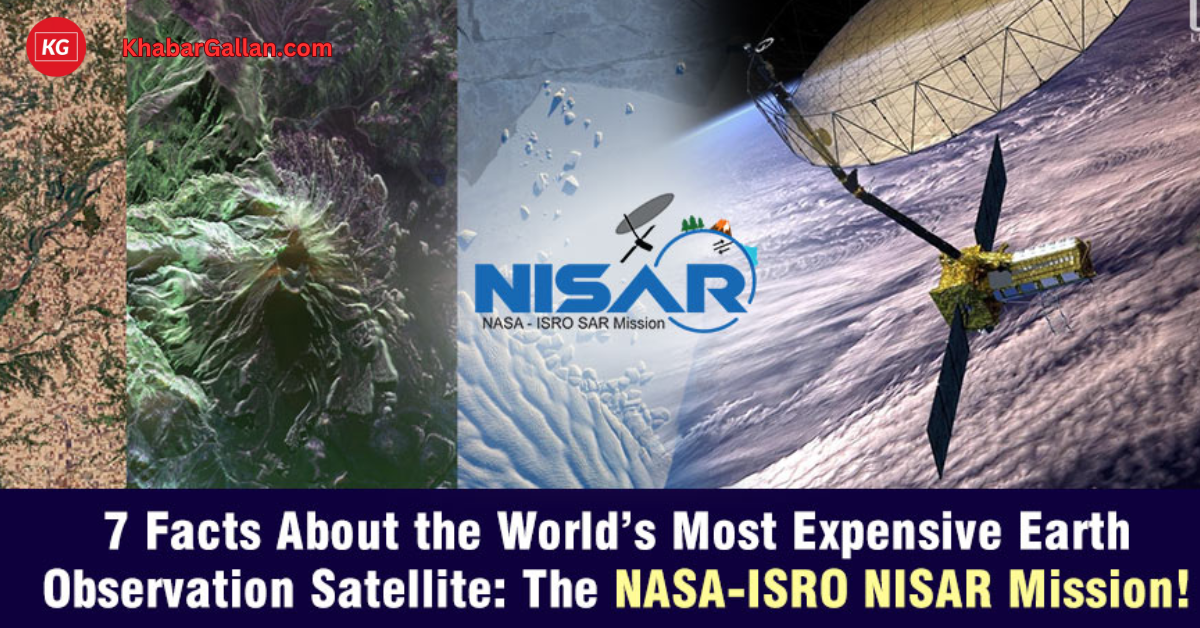On July 30, 2025, India successfully launched the NASA‑ISRO Synthetic Aperture Radar (NISAR) satellite from the Satish Dhawan Space Centre in Sriharikota, aboard the GSLV‑F16 rocket. This landmark $1.5 billion mission represents the first-ever dedicated Earth‑observation satellite jointly built by ISRO and NASA.
🚀 NISAR at a Glance
- Launch Date & Time: July 30, 2025, at 17:40 IST (12:10 UTC) aboard GSLV‑F16
- Orbit: Sun‑synchronous polar at approximately 743–745 km altitude, with 98.4° inclination
- Mass: About 2,392 kg (some reports mention 2,393 kg)
🌍 Technical Marvel: Dual‑Frequency SAR
NISAR integrates two complementary Synthetic Aperture Radars:
- NASA’s L‑band radar (longer wavelengths) that penetrates vegetation, ice, and soil
- ISRO’s S‑band radar (shorter wavelengths) sensitive to surface features like foliage and terrain
These are mounted on a 12‑meter mesh reflector antenna, one of the largest ever deployed in orbit. The mission also employs SweepSAR technology—allowing wide swath (≈242 km) imaging at high spatial resolution (5–10 m) every 12 days, regardless of weather or daylight.
🎯 Mission Objectives & Applications
NISAR’s science and social-sensing goals are vast:
- Natural disasters: Detect centimeter-scale land deformation caused by earthquakes, landslides, volcanic activity
- Glacier and ice monitoring: Track ice-sheet motion and melting in polar regions
- Environmental studies: Monitor forest cover changes, soil moisture, crop growth, wetlands, and coastal erosion
- Disaster response: Provide near-real-time imagery to aid relief operations in tropical cyclones, flooding, and wildfires
- Infrastructure & hydrology: Monitor dams, bridges, groundwater depletion, ship detection, shoreline shifts, and soil saturation levels
🤝 Why It Matters: Diplomacy, Data & Disaster Preparedness
- International cooperation: NISAR is the first mission of its kind under a 50:50 partnership between ISRO and NASA’s JPL, blending Indian launch capability and infrastructure with U.S. radar technology and data policy.
- Open data access: The satellite’s radar data will be freely available to researchers, policymakers, disaster management agencies, and global science communities—advancing transparency and global collaboration.
- Cost-effective innovation: With a roughly $1.5 billion price tag (NASA: ~$1.2 billion; India: ~$91–300 million), the mission showcases India’s ability to deliver high-impact space systems on modest budgets.
- Disaster resilience: Indian officials, including Minister Jitendra Singh, heralded NISAR as a “game‑changer” for monitoring landslides, volcanoes, cyclones, and even aiding sectors like aviation and maritime transport by piercing through fog, clouds, and ice.
🛠️ Timeline: A Journey of Delay and Resolution
Originally expected in early 2024, the launch was postponed due to hardware issues. In particular, the large antenna reflector raised thermal risks and needed upgrades at JPL before reintegration. By January–May 2025, the satellite completed testing, transport from Bengaluru to Sriharikota, and preparation aboard the rocket.
✍️ Looking Ahead
NISAR is currently in its commissioning phase, which lasts approximately 90 days. During this period, critical steps like deploying its enormous radar boom and calibrating systems are ongoing. Full science operations are expected by October 2025.
Its three‑ to five‑year mission life (depending on source) will yield continuous, high‑resolution Earth data—fueling climate models, informing policy, and enabling proactive disaster response globally.
🧭 Conclusion
India’s successful launch of NISAR on July 30, 2025 marks a watershed moment in global Earth observation. This mission combines cutting-edge dual‑frequency radar technology, open-access data policies, and strategic international teamwork to bolster climate science, disaster resilience, and sustainable development. NISAR is not just a satellite—it is a sentinel for Earth’s future.












Leave a Reply